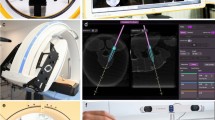Abstract
Background and Purpose:
Long fluoroscopic times and related radiation exposure are a universal concern when C-arm fluoroscopy is used to guide percutaneous procedures. Fluoroscopy-based surgical navigation has been proposed as an alternative guidance method requiring limited fluoroscopic times to achieve precision. The purpose of this experimental study was to compare fluoroscopy-based surgical navigation with C-arm fluoroscopy for guidance with respect to the precision achieved, the fluoroscopic time, and the resources needed.
Material and Methods:
114 guide wires were placed in 38 synthetic bone models using either C-arm fluoroscopy (group A) or fluoroscopy-based surgical navigation (group B) for guidance. Precision of guide wire placement was rated on the basis of an individual CT scan on all fracture models of both groups. The fluoroscopic time, the procedure time, and the number of attempts required to place the guide wires were documented as well.
Results:
An average fluoroscopic time of 26 s was needed with C-arm fluoroscopy to place three guide wires compared with an average fluoroscopic time of 2 s that was needed when fluoroscopy-based surgical navigation was used for guidance (p < 0.0001). Precision of guide wire placement and procedure times required to place the guide wires did not differ significantly between both groups. The number of attempts required for correct placement was found significantly reduced with fluoroscopy-based surgical navigation when compared with fluoroscopic guidance (p = 0.04).
Conclusion:
Fluoroscopic times to achieve precision are reduced with fluoroscopy-based surgical navigation compared with C-arm fluoroscopy. The impact of this new technique on minimally invasive, percutaneous procedures has to be evaluated in controlled prospective clinical studies.
Similar content being viewed by others
Author information
Authors and Affiliations
Corresponding author
Rights and permissions
About this article
Cite this article
Suhm, N., Beck, T., Zuna, I. et al. Fluoroscopy-Based Surgical Navigation versus Fluoroscopic Guidance to Control Guide Wire Insertion for Osteosynthesis of Femoral Neck Fractures. Eur J Trauma 30, 23–28 (2004). https://doi.org/10.1007/s00068-004-1267-2
Received:
Accepted:
Issue Date:
DOI: https://doi.org/10.1007/s00068-004-1267-2




